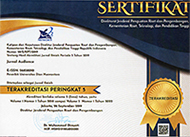TEORI JANGKAR SEMANTIK PADA WARNA SERTA PENERAPANNYA PADA FOTOGRAFI IKLAN
DOI:
https://doi.org/10.33633/ja.v1i2.2688Abstract
AbstrakPenelitian ini merupakan wahana titik balik (back to basic), di mana kita akandibukakan kembali tehadap pentingnya elemen warna dalam aplikasi seni rupa.Penelitian ini berusaha mengungkapkan warna sebagai bagian dari fenomena tandasecara khusus penerapanya di desain komunikasi visual. Pemahaman ulang (yanglebih dalam) mengenai warna meliputi psikologi warna, makna warna, dan proseswarna menjadi makna. Penelitian ini memperkenalkan teori â€jangkar semantik†yangmerupakan sebuah metode dalam membedah makna warna. Penelitian inimenggunakan sampel warna merah yang diaplikasikan pada karya desainkomunikasi visual namun dalam implementasinya nanti teori jangkar semantik jugabisa digunakan pada warna lainnya. Kata kunci: Warna, jangkar semantik, semiotika, iklan, Desain Komunikasi VisualAbstractThe study is a step backward point (back to basic), about the importance of color elements in the application of visual art. This research will reveal colors as part of the sign phenomenon specifically its application in visual communication design. Reunderstanding (deeper) about color includes colorpsychology,colormeaning,andcolorprocessinto meaning.Thisstudy introducesthe "semanticanchor"theory,whichis a methodof uncoveringcolormeanings.Thisstudyusesredas a samplethatis appliedto visualcommunicationdesignworkbut in its implementationlaterthesemanticanchortheorycanalsobe usedinother colors.Keywords: Colors, Semantic Anchor, Semiotic, Visual Communication DesignÂDownloads
Published
2019-07-23
Issue
Section
Articles
License
Authors who publish with this journal agree to the following terms:
- Authors retain copyright and grant the journal right of first publication with the work simultaneously licensed under a Creative Commons Attribution License that allows others to share the work with an acknowledgment of the work's authorship and initial publication in this journal.
- Authors are able to enter into separate, additional contractual arrangements for the non-exclusive distribution of the journal's published version of the work (e.g., post it to an institutional repository or publish it in a book), with an acknowledgment of its initial publication in this journal.
- Authors are permitted and encouraged to post their work online (e.g., in institutional repositories or on their website) prior to and during the submission process, as it can lead to productive exchanges, as well as earlier and greater citation of published work (See The Effect of Open Access).





















